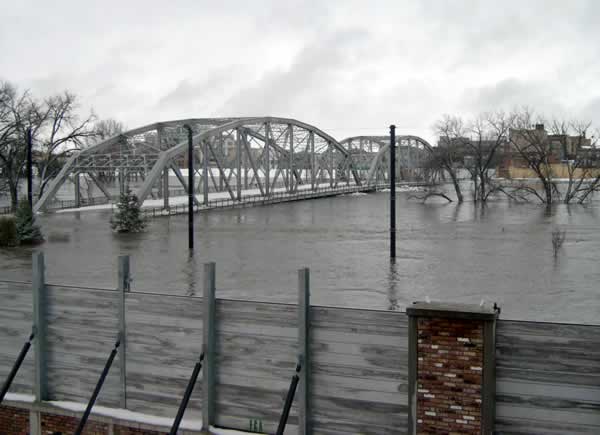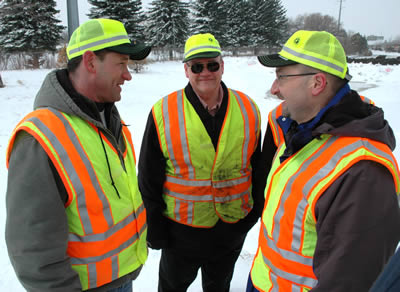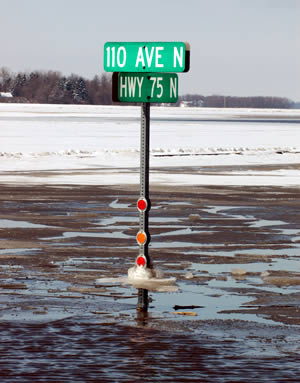By Chris Krueger

Flood waters cover the deck of District 2's Sorlie Bridge on Business Highway 2, which connects East Grand Forks and Grand Forks. A flood wall is seen in the foreground. This same bridge was submerged three years ago as well. Photo by J.T. Anderson |
One person described the weather conditions as “down right ugly up here.”
Freezing rain, and more than two feet of snow in some areas, have temporarily transformed the Red River Valley’s rich agricultural flatlands to resemble the glacial lakes that once covered the area.
Whether setting up barriers and flashers for traffic control, building dikes along Interstate 94 to protect the freeway and a large Moorhead neighborhood, or coordinating with local partners, staff at Mn/DOT’s District 2 and District 4 offices are working 24/7 to keep the floodwater off the roads and away from critical infrastructure.
“The weather is just like Yertle the Turtle,” said Lynn Eaton, District 2 engineer, referring to a children’s story by Dr. Seuss. “It’s one thing on top of another.”

Jeff Perkins, District 4 area operations manager, Lee Berget, District 4 engineer, and Commissioner Tom Sorel debrief March 30 about Mn/DOT operations in the Moorhead area, which included building a dike along Interstate 94. Photo by Kevin Gutknecht |
Staff response has been tremendous, Eaton said.
“I’m struck by how they take this kind of thing in stride. This is our New York City firefighter moment. They just step up and I’m really proud of them.”
Jeff Perkins, District 4 area operations manager, also expressed appreciation for area staff, as well as operators from other districts, who came last week for the flood and stayed to work the blizzard that hit the area early this week.
“I’m absolutely amazed at their work ethic, enthusiasm and the teamwork they showed throughout the entire event. It freed us up to assist the city of Moorhead so they could focus on other priorities. The city really appreciated that.”
Mn/DOT’s response has been diverse and coordinated.
The department has provided the city of Moorhead with winter sand, clay, bulldozers and trucks for building dikes. Crews in District 4 manned pumps to free up Moorhead Public Works staff. Staff has worked with the State Emergency Operating Center in St. Paul and multiple federal agencies to break up an ice dam in Oslo that endangered a railroad bridge and a Highway 1 bridge across the Red River in to North Dakota. Other districts far from the floodwaters have fulfilled requests for assistance. Metro District, for example, sent two Vactor trucks to unplug 27 manholes in Moorhead.
District 4 worked about 15 hours on March 25 and another 19 hours March 26 in blizzard conditions using 14,000 yards of material to build a dike to protect I-94. They finished just after midnight, and water started rising up the sides of the dike by 8 a.m. The changing weather conditions also made operators quick-change artists as they converted trucks from hauling materials one day to pushing snow the next.

Much of Hwy 75, such as this section north of Moorhead, is under several feet of water due to massive flooding in the Red River Valley. Photo by David Gonzalez |
In addition to the dozens of field workers, office and supervisory staff also have contributed their skills and expertise.
In response to a Clay County request, for example, Mn/DOT’s GIS Unit worked to consolidate city and county maps for ease of use, providing an important tool for relief workers and the public. One supervisor worked with the U.S. Corp of Engineers to find open roads and map a viable route to Hendrum, Minn., so a much-needed generator could be delivered.
Since the SEOC opened March 18, Dana Hanson, District 4 public affairs coordinator, has written and distributed 17 news releases warning motorists of closed roads and encouraging safe driving in roads covered with water, blowing snow and black ice.
Preparation has helped, Eaton said.
“I’m happy we went through the FEMA Incident Command Staff training. It was very beneficial,” he said. “We have had good things in place – and now we’re even better.”
As of April 1, the weather was providing a bit of a breather to the Moorhead area. Staff began punching holes through dikes to get traffic back on ramps. District 4 was sending people back to their home districts, although they are keeping the bulk of equipment so they are ready when the river crests again next week, possibly above the historic 1997 levels.
In District 2, Eaton described the flood as “insidious.”
“We know it’s coming. We know where things will go awry. We know our course of action,” he said. “We just wait it out.”
|



